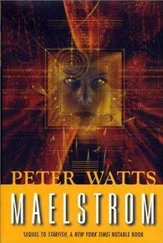Sarasti was right: Rorschach wouldn’t do anything to you that you don’t already do to yourself.
For example, the invisibility trick of that young, dumb scrambler—the one who restricted its movement to the gaps in Human vision—occured to me while reading about something called inattentional blindness . A Russian guy called Yarbus was the first to figure out the whole saccadal glitch in Human vision, back in the nineteen sixties. [15] Yarbus, A.L. 1967. Eye movements during perception of complex objects. In L. A. Riggs, Ed., Eye Movements and Vision, Plenum Press, New York, Chapter VII, 171-196.
Since then, a variety of researchers have made objects pop in and out of the visual field unnoticed, conducted conversations with hapless subjects who never realised that their conversational partner had changed halfway through the interview, and generally proven that the Human brain just fails to notice an awful lot of what’s going on around it. [16] Pringle, H.L., et al. 2001. The role of attentional breadth in perceptual change detection. Psychonomic Bulletin & Review 8: 89-95(7).
, [17] Simons, D.J., and Chabris, C.F. 1999. Gorillas in our midst: sustained inattentional blindness for dynamic events. Perception 28: 1059-1074.
, [18] Simons, D.J., and Rensink, R.A. 2003. Induced Failures of Visual Awareness. Journal of Vision 3(1).
. Check out the demos at the website of the Visual Cognition Lab at the University of Illinois [19] http://viscog.beckman.uiuc.edu/djs_lab/demos.html . [This link has moved to http://www.simonslab.com/videos.html - update by EH, 2011-07-13 ].
and you’ll see what I mean. This really is rather mind-blowing, people. There could be Scientologists walking among us right now and if they moved just right, we’d never even see them .
Most of the psychoses, syndromes, and hallucinations described herein are real, and are described in detail by Metzinger, [20] Metzinger, T. 2003. Being No One: The Self-Model Theory of Subjectivity. MIT Press, Cambridge, MA. 713pp.
Wegner, [21] Wegner, D.M. 2002. The Illusion of Conscious Will. MIT Press, Cambridge. 405pp.
and/or Sacks [22] Sacks, O. 1970. The Man who mistook his wife for a hat and other clinical tales. Simon & Shuster, NY.
(see also Sentience/Intelligence , below). Others ( e.g. Grey Syndrome) have not yet made their way into the DSM [23] American Psychiatric Association. 2000. Diagnostic and Statistical Manual of Mental Disorders. (4th Ed., Text Revision). Brandon/Hill.
—truth be told, I invented a couple—but are nonetheless based on actual experimental evidence. Depending upon whom you believe, the judicious application of magnetic fields to the brain can provoke everything from religious rapture [24] Ramachandran, V.S., and Blakeslee, S. 1998. Phantoms in the Brain: Probing the Mysteries of the Human Mind. William Morrow, New York.
to a sense of being abducted by aliens. [25] Persinger, M.A. 2001 The Neuropsychiatry of Paranormal Experiences. J Neuropsychiatry & Clinical Neuroscience 13: 515-524.
Transcranial magnetic stimulation can change mood, induce blindness, [26] Kamitani, Y. and Shimojo, S. 1999. Manifestation of scotomas created by transcranial magnetic stimulation of human visual cortex. Nature Neuroscience 2: 767-771.
or target the speech centers (making one unable to pronounce verbs, for example, while leaving the nouns unimpaired). [27] Hallett, M. 2000. Transcranial magnetic stimulation and the human brain. Nature 406: 147-150.
Memory and learning can be enhanced (or impaired), and the US Government is presently funding research into wearable TMS gear for—you guessed it—military purposes. [28] Goldberg, C. 2003. Zap! Scientist bombards brains with super-magnets to edifying effect. Boston Globe 14/1/2003, pE1.
Sometimes electrical stimulation of the brain induces “alien hand syndrome”—the involuntary movement of the body against the will of the “person” allegedly in control. [29] Porter, R., and Lemon, R. 1993. Corticospinal function and voluntary movement. Oxford University Press, NY.
Other times it provokes equally involuntary movements, which subjects nonetheless insist they “chose” to perform despite overwhelming empirical evidence to the contrary. [30] Delgado, J.M.R. 1969. Physical control of the mind: toward a psychocivilised society. Harper & Row, NY.
Put all this together with the fact that the body begins to act before the brain even “decides” to move [31] Libet, B. 1993. The neural time factor in conscious and unconscious events. Experimental and Theoretical Studies of Consciousness 174: 123-146.
(but see [32] P. Haggard, P., and Eimer , M. 1999. On the relation between brain potentials and the awareness of voluntary movements. Experimental Brain Research 126: 128-133.
, [33] Velmans, M. 2003. Preconscious free will. Journal of Consciousness Studies 10: 42-61.
), and the whole concept of free will —despite the undeniable subjective feeling that it’s real—begins to look a teeny bit silly, even outside the influence of alien artefacts.
While electromagnetic stimulation is currently the most trendy approach to hacking the brain, it’s hardly the only one. Gross physical disturbances ranging from tumors [34] Pinto, C. 2003. Putting the brain on trial. May 5, 2003, Media General News Service.
to tamping irons [35] Macmillan, M. 2000. An Odd Kind of Fame Stories: of Phineas Gage. MIT Press, Cambridge, MA.
can turn normal people into psychopaths and pedophiles (hence that new persona sprouting in Susan James’s head). Spirit possession and rapture can be induced through the sheer emotional bump-and-grind of religious rituals, using no invasive neurological tools at all (and not even necessarily any pharmacological ones). [36] Wegner, D.M. 2002. The Illusion of Conscious Will. MIT Press, Cambridge. 405pp.
People can even develop a sense of ownership of body parts that aren’t theirs, can be convinced that a rubber hand is their real one. [37] Ehrsson, H.H., C. Spence, and R.E. Passingham 2004. That’s My Hand! Activity in Premotor Cortex Reflects Feeling of Ownership of a Limb. Science 305: 875-877.
Vision trumps propioreception: a prop limb, subtly manipulated, is enough to convince us that we’re doing one thing while in fact we’re doing something else entirely [38] Gottleib, J., and P. Mazzoni. 2004. Action, illusion, and perception. Science 303: 317-318.
, [39] Schwartz, A.B., D.W. Moran, and G.A. Reina. 2004. Differential representation of perception and action in the frontal cortex. Science 303: 380-383.
.
The latest tool in this arsenal is ultrasound: less invasive than electromagnetics, more precise than charismatic revival, it can be used to boot up brain activity [40] Norton, S.J., 2003. Can ultrasound be used to stimulate nerve tissue? BioMedical Engineering OnLine 2:6, available at http://www.biomedical-engineering-online.com/content/2/1/6 .
without any of those pesky electrodes or magnetic hairnets. In Blindsight it serves as a convenient back door to explain why Rorschach ’s hallucinations persist even in the presence of Faraday shielding—but in the here and now, Sony has been renewing an annual patent for a machine which uses ultrasonics to implant “sensory experiences” directly into the brain. [41] Hogan, J., and Fox, B. 2005. Sony patent takes first step towards real-life Matrix. Excerpted from New Scientist 2494:10, available at http://www.newscientist.com/article.ns?id=mg18624944.600 .
They’re calling it an entertainment device with massive applications for online gaming. Uh huh. And if you can implant sights and sounds into someone’s head from a distance, why not implant political beliefs and the irresistable desire for a certain brand of beer while you’re at it?
Читать дальше








